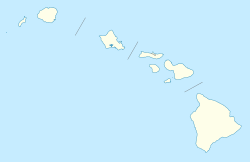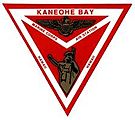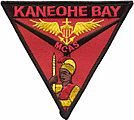Marine Corps Air Station Kaneohe Bay facts for kids
Quick facts for kids Marine Corps Air Station Kaneohe Bay |
|||||||
|---|---|---|---|---|---|---|---|
| Marion E. Carl Field | |||||||
| Part of Marine Corps Base Hawaii | |||||||
| Near Kaneohe, Hawaii in the United States | |||||||
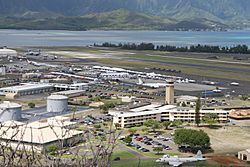
An aerial view of MCAS Kaneohe Bay during 2010.
|
|||||||
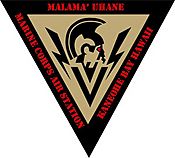 |
|||||||
|
Location in Hawaii
|
|||||||
| Coordinates | 21°26′45″N 157°46′11″W / 21.44583°N 157.76972°W | ||||||
| Type | Marine Corps Air Station | ||||||
| Site information | |||||||
| Owner | Department of Defense | ||||||
| Operator | US Marine Corps | ||||||
| Controlled by | 1st Marine Aircraft Wing | ||||||
| Condition | Operational | ||||||
| Site history | |||||||
| Built | 1939 | ||||||
| In use | 1939 – 1949 (US Navy) 1952 – present (US Marine Corps) |
||||||
| Garrison information | |||||||
| Current commander |
Lieutenant Colonel Tyler J. Holland | ||||||
| Garrison | Marine Aircraft Group 24 | ||||||
| Airfield information | |||||||
| Identifiers | IATA: NGF, ICAO: PHNG, FAA LID: NGF, WMO: 911760 | ||||||
| Elevation | 7 metres (23 ft) AMSL | ||||||
|
|||||||
Marine Corps Air Station Kaneohe Bay (often called MCAS Kaneohe Bay) is a special airport for the United States Marine Corps. It's part of a bigger military base called Marine Corps Base Hawaii. This air station is located near Kaneohe, in Hawaii, United States. It has one main runway made of asphalt that is about 2.3 kilometers (1.4 miles) long.
Contents
History of Kaneohe Bay Air Station
Early Days as Fort Hase
The land where MCAS Kaneohe Bay now stands was first used by the United States Army. In 1918, President Woodrow Wilson signed an order to create the Kuwaaohe Military Reservation. Not much is known about what happened there during World War I. After the war, the land was even leased out for ranching.
In 1939, the military started using the area again. It had a few different names before finally being called Fort Hase. Before and during World War II, Fort Hase grew from a small defense spot into a big part of the Windward Coastal Artillery Command.
In 1939, the Navy decided this peninsula would be a great place for a seaplane base. They liked that it was isolated and had flat land for an airfield. This was perfect for their PBY Catalina seaplanes, which were used for long-distance flights.
By 1940, the Navy owned almost all of the Mokapu Peninsula. They started building the base in 1939. During this time, the Navy also used special construction units called Seabees to help build more parts of the base.
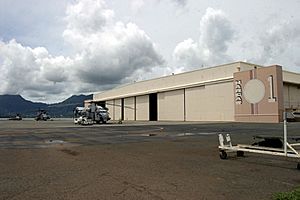
Attack on Pearl Harbor
On December 7, 1941, the Imperial Japanese Navy attacked the air station. This happened just minutes before the famous attack on Pearl Harbor. Many of the 36 Catalina seaplanes stationed there were destroyed or damaged.
During this attack, 18 sailors lost their lives. The first Japanese aircraft shot down during the war happened at Kaneohe. Also, Aviation Ordnanceman Chief Petty Officer John William Finn showed great bravery that day. He became one of the first people to receive the Medal of Honor in World War II.
Wartime Training and Post-War Changes
Throughout World War II, the air station was a very important training base. Thousands of Navy gunners learned their skills here. There were also schools for navigation, sonar, and how to recognize aircraft. Flight instructors trained Navy and Marine Corps pilots before they went to fight.
After the war, Fort Hase became a small outpost. The air station had limited flights and a small security team. In 1958, a system was set up here to track missiles for the Navy's Pacific Missile Range.
Marine Corps Takes Over
In 1949, the Navy closed the air station. But on January 15, 1952, the Marine Corps reopened it. They renamed it Marine Corps Air Station Kaneohe Bay. It became a great place to train combined air and ground teams.
Over the years, different squadrons supported the flight operations. In 1994, the Marine Corps Air Facility Kaneohe Bay was formed. It still helps with the aviation needs of the base today.
On May 28, 1987, the station was recognized as a historic district and a National Historic Landmark. This was because of its important role in World War II.
After another base, Naval Air Station Barbers Point, closed in 1993, MCAS Kaneohe Bay gained more aircraft. It received four Navy P-3 Orion patrol squadrons and one SH-60 Seahawk anti-submarine squadron. Today, nearly 10,000 Navy and Marine Corps personnel work here. They are led by Marine Aircraft Group 24 and Navy Patrol and Reconnaissance Wing 2.
In May 2009, the base was officially called an Air Station again. The airfield was also named Marion E. Carl Field, after MajGen Marion Eugene Carl. New squadrons were also announced to be stationed there.
On January 15, 2016, two Marine helicopters from the air station collided over the North Shore of Oahu. This event resulted in 12 US Marines being missing.
Units Based at MCAS Kaneohe Bay
Many different flying and non-flying units are based at MCAS Kaneohe Bay.
United States Marine Corps Units
- Marine Corps Installations – Pacific
- Headquarters and Headquarters Squadron – They fly the C-20G Gulfstream IV aircraft.
- 1st Marine Aircraft Wing
- Marine Aircraft Group 24
- Marine Light Attack Helicopter Squadron 367 (HMLA-367) – They use AH-1Z Viper and UH-1Y Venom helicopters.
- Marine Heavy Helicopter Squadron 463 (HMH-463) – They fly the large CH-53E Super Stallion helicopters.
- Marine Unmanned Aerial Vehicle Squadron 3 (VMU-3) – This unit uses RQ-21A Blackjack drones.
- Marine Medium Tilt-Rotor Squadron 268 (VMM-268) – They operate the unique MV-22B Osprey, which can fly like a plane and a helicopter.
- Marine Aircraft Group 24
- Commander, Helicopter Maritime Strike Wing Pacific (CHMSWP)
- Helicopter Maritime Strike Squadron 37 (HSM-37) – They fly MH-60R helicopters.
- Commander, Patrol and Reconnaissance Wing 10 (CPRW-10)
- Special Projects Patrol Squadron 2 (VPU-2) – This unit uses P-3C Orion aircraft for special missions.
- Commander, Fleet Logistics Support Wing (CFLSW)
- Fleet Logistics Support Squadron 51 (VR-51) – They fly C-40A Clipper planes for transport.
Insignia


